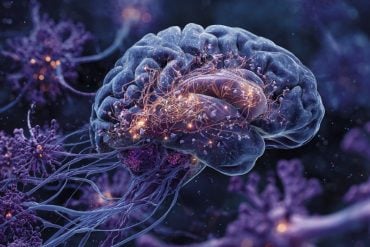Summary: Study shows how Toxoplasma parasitic infections promote the loss of inhibitory signaling in the brain by altering the behavior of microglia.
Source: Virginia Tech
Think about traffic flow in a city – there are stop signs, one-way streets, and traffic lights to organize movement across a widespread network. Now, imagine what would happen if you removed some of the traffic signals.
Among your brain’s 86 billion neurons are the brain’s own version of stop signals: inhibitory neurons that emit chemicals to help regulate the flow of ions traveling down one cell’s axon to the next neuron. Just as a city without traffic signals would experience a spike in vehicle accidents, when the brain’s inhibitory signals are weakened, activity can become unchecked, leading to a variety of disorders.
In a new study published in GLIA on March 11, Virginia Tech neuroscientists at the Fralin Biomedical Research Institute at VTC describe how the common Toxoplasma gondii parasite prompts the loss of inhibitory signaling in the brain by altering the behavior of nearby cells called microglia.
The Centers for Disease Control and Prevention estimates that 40 million Americans have varying levels of Toxoplasma infection, although most cases are asymptomatic. Commonly passed to humans via exposure to farm animals, infected cat litter, or undercooked meat, the parasitic infection causes unnoticeable or mild, to flu-like symptoms in most healthy people. But for a small number of patients, these microscopic parasites hunker down inside of neurons, causing signaling errors that can result in seizures, personality and mood disorders, vision changes, and even schizophrenia.
“After the initial infection, humans will enter a phase of chronic infection. We wanted to examine how the brain circuitry changes in these later stages of parasitic cyst infection,” said Michael Fox, a professor at the Fralin Biomedical Research Institute and the study’s lead author.
The parasite forms microscopic cysts tucked inside of individual neurons.
“The theory is that neurons are a great place to hide because they fail to produce some molecules that could attract cells of the immune system,” said Fox, who is also director of the research institute’s Center for Neurobiology Research.
Fox and his collaborator, Ira Blader, recently reported that long-term Toxoplasma infections redistribute levels of a key enzyme needed in inhibitory neurons to generate GABA, a neurotransmitter released at the specialized connection between two neurons, called a synapse.
Building on that discovery, the scientists revealed that persistent parasitic infection causes a loss of inhibitory synapses, and they also observed that cell bodies of neurons became ensheathed by other brain cells, microglia. These microglia appear to prevent inhibitory interneurons from signaling to the ensheathed neurons.
“In neuropsychiatric disorders, similar patterns of inhibitory synapse loss have been reported, therefore these results could explain why some people develop these disorders post-infection,” Fox said.
Fox said the inspiration for this study started years ago when he met Blader, a collaborating author and professor of microbiology and immunology at the University at Buffalo Jacobs School of Medicine and Biomedical Sciences, after he delivered a seminar at Virginia Tech. Blader studied Toxoplasma gondii and wanted to understand how specific strands of the parasite impacted the retina in mouse models.
Working together, the two labs found that while the retina showed no remarkable changes, inhibitory interneurons in the brain were clearly impacted by the infection. Mice – similar to humans – exhibit unusual behavioral changes after Toxoplasma infection. One hallmark symptom in infected mice is their tendency to approach known predators, such as cats, displaying a lack of fear, survival instincts, or situational processing.
“Even though a lot of neuroscientists study Toxoplasma infection as a model for immune response in the brain, we want to understand what this parasite does to rewire the brain, leading to these dramatic shifts in behavior,” Fox said.

Future studies will focus on further describing how microglia are involved in the brain’s response to the parasite.
Among the research collaborators is Gabriela Carrillo, the study’s first author and a graduate student in the Translational Biology, Medicine, and Health Program. Previously trained as an architect before pursuing a career in science, Carrillo chose this topic for her doctorate dissertation because it involves an interdisciplinary approach.
“By combining multiple tools to study infectious disease and neuroscience, we’re able to approach this complex mechanistic response from multiple perspectives to ask entirely new questions,” Carrillo said. “This research is fascinating to me because we are exposing activated microglial response and fundamental aspects of brain biology through a microbiological lens.”
The study’s other contributing authors include Valerie Ballard, a Roanoke Valley Governor’s School high school student; Taylor Glausen, a graduate student working in Blader’s laboratory at the University at Buffalo; Zack Boone, a Virginia Tech undergraduate student; Cyrus Hinkson, a fourth-year Virginia Tech Carilion School of Medicine student; and Elizabeth Wohlfert, an assistant professor of microbiology and immunology at the University at Buffalo.
Source:
Virginia Tech
Media Contacts:
Whitney Slightham – Virginia Tech
Image Source:
The image is in the public domain.
Original Research: Closed access
“Toxoplasma infection induces microglia‐neuron contact and the loss of perisomatic inhibitory synapses”. Gabriela L. Carrillo, Valerie A. Ballard, Taylor Glausen, Zack Boone, Joseph Teamer, Cyrus L. Hinkson, Elizabeth A. Wohlfert, Ira J. Blader, Michael A. Fox.
GLIA doi:10.1002/glia.23816.
Abstract
Toxoplasma infection induces microglia‐neuron contact and the loss of perisomatic inhibitory synapses
Infection and inflammation within the brain induces changes in neuronal connectivity and function. The intracellular protozoan parasite, Toxoplasma gondii, is one pathogen that infects the brain and can cause encephalitis and seizures. Persistent infection by this parasite is also associated with behavioral alterations and an increased risk for developing psychiatric illness, including schizophrenia. Current evidence from studies in humans and mouse models suggest that both seizures and schizophrenia result from a loss or dysfunction of inhibitory synapses. In line with this, we recently reported that persistent T. gondii infection alters the distribution of glutamic acid decarboxylase 67 (GAD67), an enzyme that catalyzes GABA synthesis in inhibitory synapses. These changes could reflect a redistribution of presynaptic machinery in inhibitory neurons or a loss of inhibitory nerve terminals. To directly assess the latter possibility, we employed serial block face scanning electron microscopy (SBFSEM) and quantified inhibitory perisomatic synapses in neocortex and hippocampus following parasitic infection. Not only did persistent infection lead to a significant loss of perisomatic synapses, it induced the ensheathment of neuronal somata by myeloid‐derived cells. Immunohistochemical, genetic, and ultrastructural analyses revealed that these myeloid‐derived cells included activated microglia. Finally, ultrastructural analysis identified myeloid‐derived cells enveloping perisomatic nerve terminals, suggesting they may actively displace or phagocytose synaptic elements. Thus, these results suggest that activated microglia contribute to perisomatic inhibitory synapse loss following parasitic infection and offer a novel mechanism as to how persistent T. gondii infection may contribute to both seizures and psychiatric illness.







